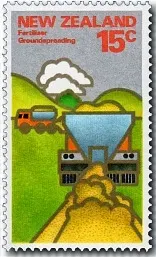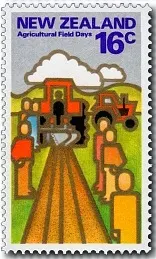 I hesitated on doing this set because of the style of the stamps but then decided that the themes behind the designs are important to Agriculture and New Zealand's primary export industries.
I hesitated on doing this set because of the style of the stamps but then decided that the themes behind the designs are important to Agriculture and New Zealand's primary export industries.In 1978 Lincoln College celebrated its centenary. NZ Post marked the event by issuing this six value set. They also wrote on their web site:-
"The College was founded in 1878 on 100,000 acres of pastoral land that had been set aside for the purpose by the Provincial Council of Canterbury. Mr W E Ivey was appointed the first director of the College. Grassland farming is New Zealand's most important industry and the source of over 80 percent of the country's exports. The College continues to develop its resources to meet the challenges of modern agricultural needs - through the application of the findings of research, use of machinery, topdressing of pasture and efficient agricultural management."
Technology and knowledge are the keys to modern faming in New Zealand. New ways, new systems, new technology is being developed all the time. The problem for the New Zealand farmer is keeping up with it all. Some, like some of the smaller farmers around here, avoid everything new and stick to the ways they have always done it. Others like us, with the support and backing of a corporate investment company, take on and use new technology, new ideas. The result is the small farmer gets the same results he has always got, then can't understand how our average production per head has increased by nearly 20% compared to his.
This knowledge can be gained from a variety of sources such as Magazines and Books, TV Shows, Field Days and Open Days. It can also be gained through education at farming schools, colleges and universities. Two of the staff who work for me currently attend a school one day a week, plus have assignments to do. As they progress through the various subjects I can see the changes in the way they view farming and go about their daily tasks.
Centenary of Lincoln College (1878 - 1978) - 10c
Ivey Hall and students.
Ivey Hall and students.
Centenary of Lincoln College (1878 - 1978) - 12c
The rural agricultural nature of the College is illustrated on this stamp with sheep, rolling hills, grasslands and trees.
The rural agricultural nature of the College is illustrated on this stamp with sheep, rolling hills, grasslands and trees.
Fertiliser Ground Spreading - 15c
The spreading of bulk fertiliser is an important part of efficient agricultural management. The bulk fertiliser ground-spread industry has grown - in techniques and capacity - to meet the widespread challenges of our agricultural society.
The spreading of bulk fertiliser is an important part of efficient agricultural management. The bulk fertiliser ground-spread industry has grown - in techniques and capacity - to meet the widespread challenges of our agricultural society.
Agriculture Field Days - 16c
Farming skills are demonstrated to enthusiastic audiences at organised field days. here a tractor is shown ploughing.
Farming skills are demonstrated to enthusiastic audiences at organised field days. here a tractor is shown ploughing.
Harvesting Grain - 20c
Cereal and grain farming sectors are portrayed on this stamp, reaping the fruits of the harvest, so essential to the daily lives of man and beast.
Cereal and grain farming sectors are portrayed on this stamp, reaping the fruits of the harvest, so essential to the daily lives of man and beast.
Dairy Farming - 30c
Dairy farming and the important role cattle play in the New Zealand economy are represented by the cattle which, in New Zealand's mild climate, can graze outdoors throughout the year.
Dairy farming and the important role cattle play in the New Zealand economy are represented by the cattle which, in New Zealand's mild climate, can graze outdoors throughout the year.
Printing Flaws.
Below are some printing flaws we found from this issue.
1978 10c Lincoln College strip of 3 with major gold error, where the centre stamp
is almost covered with gold ink.
1978 Farming Lincoln College, 12c Sheep with the gold colour offset on back. If you compare this with the good image on the right you will be able to identify many details of the design.
Below is a similar problem on the 20c Grain Harvesting.
The gold colour has off-set on the back.
1978 Farming Lincoln College 30c Dairy Farming with double Cows caused by a major green colour shift. Compare this with the good one further up the page.
Technical information
Date of Issue:
| 26 April 1978 |
|---|---|
Designers:
| G Fuller, Havelock North |
Printers:
| Harrison and Sons, England |
Stamp Size:
| 25mm x 42mm |
Sheet Size:
| 100 stamps per sheet |
Process:
| Lithography |
Perforation Gauge:
| 14.25 |
Paper Type:
| Harrison and Sons, unwatermarked |
Some of the images in this post were used with permission from the illustrated catalogue of StampsNZ
You can visit their web site and On-line Catalogue at, http://stampsnz.com/










So for not being inspired by this set you still did Ok.
ReplyDeleteBut why is the stamp with cows up at the top? Why not one of the others.
Ha! Ha! Kirsten.
Being a dairy farmer to Kirsten, I think you know why cows was the natural choice for the header photo.
DeleteThis set is not so bad. It kind of grows on you when you look at it.
Anne.
Since this set is about Lincoln College I think you have no choice but to use the stamp (10c value) showing the college and students in the header. Anne, I suggest you change this ASAP.
DeleteRajah
Maybe the ploughing or Grain Harvesting would show technology at work on the farm.
DeleteBrian
I think the sheep Anne.
DeleteLook at those nice fluffy sheep. Aren't they better than those spotty cows?
Asami.
Hi
ReplyDeleteI am going through my New Zealand collection and found that I posses a mint version of the 10 c Lincoln College stamp but with all the upper text (New Zealand, Lincoln College etc and 10C) all in plain yellow instead of the usual orange/red ... is this a known flaw/error and if yes - how rare is it ??
Kind regards
Ole Jensen (Denmark)
Hi Ole,
DeleteYes, the red colour partly omitted on the 10c stamp is a known flaw/error according to the Campbell Paterson Catalogue (2018 Revision). They list it as being rare and worth $400.00 NZ. Of course, you would only get that amount from a serious collector/investor who wanted that error.
Anne
We appreciate your engagement with our content. To ensure a respectful and constructive community, please take note of the following:
- No Spam, Please: We do not tolerate spammy or promotional comments. Any such comments will be promptly removed.
- Moderation in Place: All comments are moderated to maintain a positive and inclusive environment. Please be patient, as it may take a little time for your comment to appear.
- Sign In with Google: To comment, please sign in using your Google account. This helps us maintain the integrity of our community and allows for better interaction.